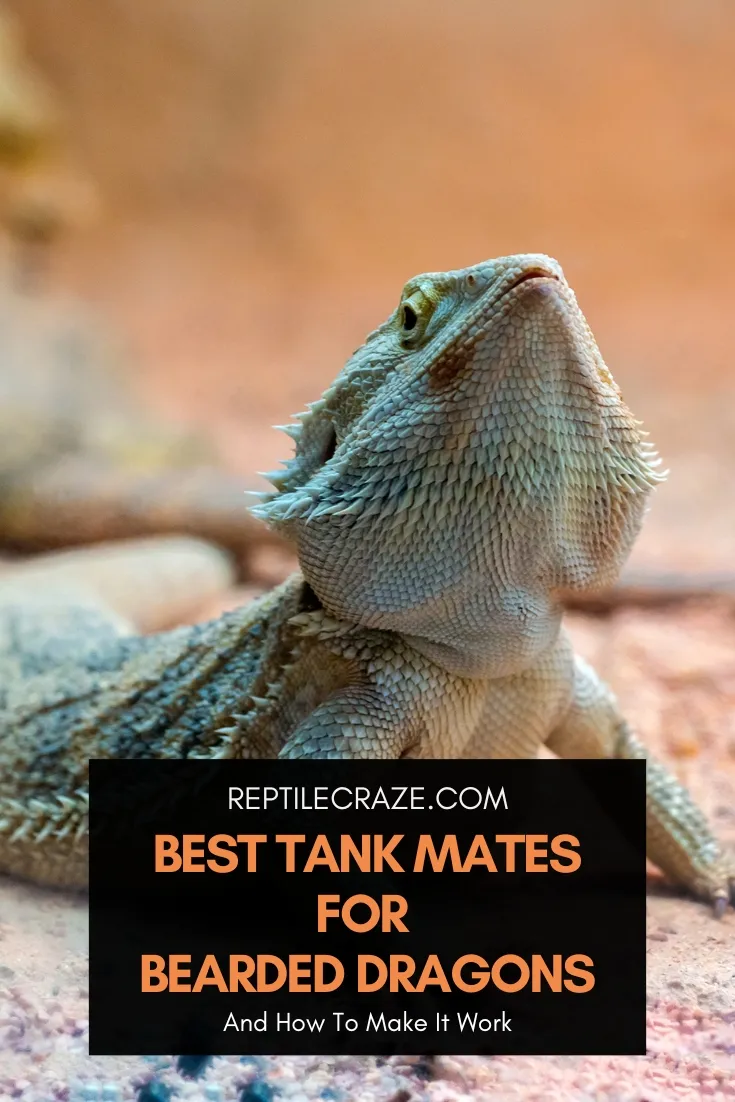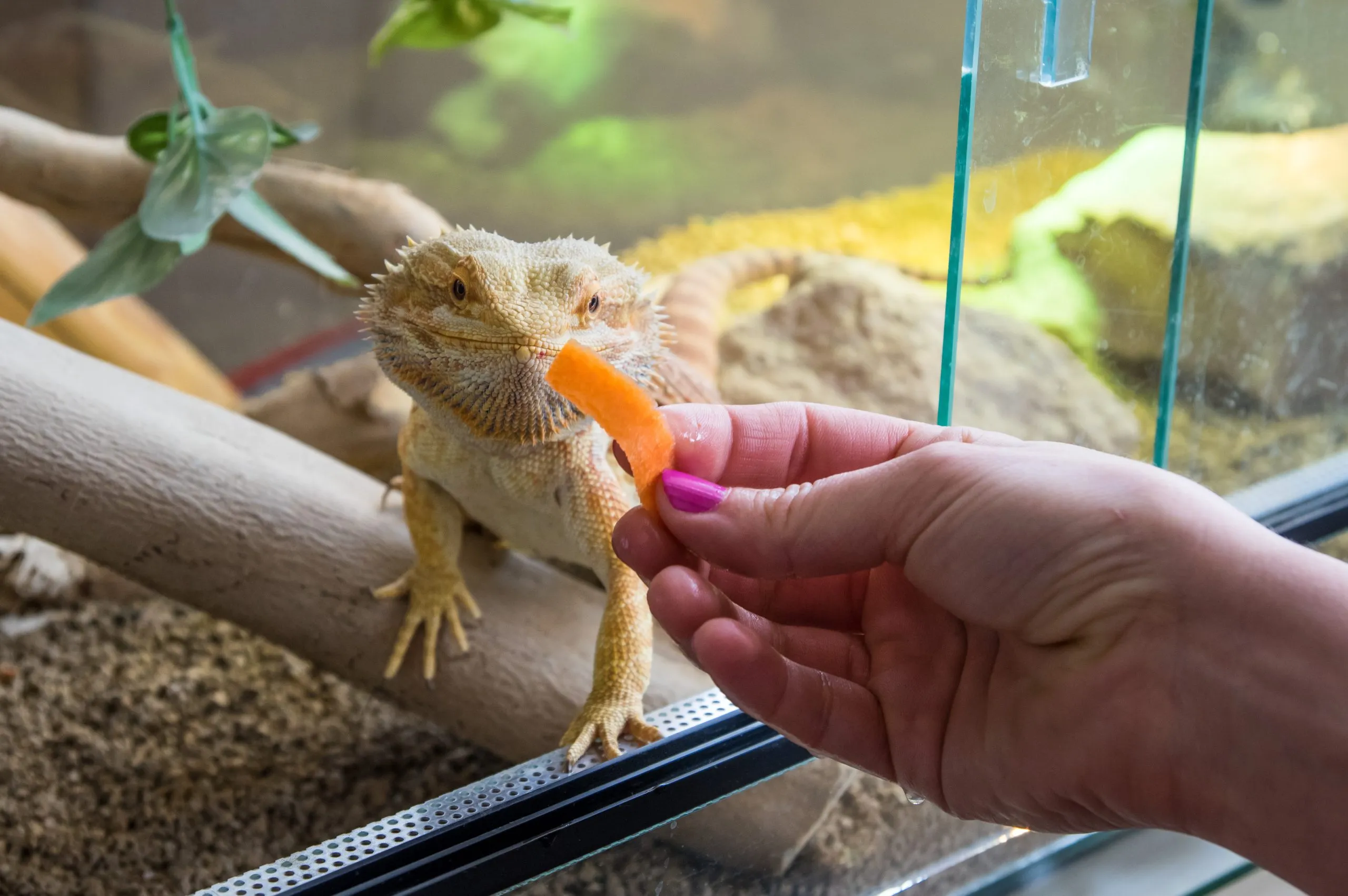
Are you considering getting a friend for your “lonely” bearded dragon? Before you do, know that bearded dragons aren’t cheered up by another cold-blooded buddy, whether it’s another dragon or a different reptile. Unlike dogs, monkeys, or parrots, most reptiles do not seek companionship to thrive.
Bearded dragons are naturally territorial and best kept alone. It shouldn’t cohabit with another bearded dragon unless it is female and for breeding. The best tankmates for bearded dragons may only include some tortoises, ackie monitors, frilled lizards, blue-tongued skinks, and nocturnal lizards.
Although bearded dragons can be housed with certain reptiles, do so cautiously. Read on to learn which reptiles can cohabit with relative safety. This article also discusses what to keep in mind if you want a bearded dragon to live with and tolerate other animals, including its kind.
Table of Contents
The Best Tank Mates For Bearded Dragons
A bearded dragon is first and foremost a solitary creature. They don’t need another bearded dragon or any other reptile to keep them happy. They are happy and content being by themselves.
In fact, you may be their best companion if they don’t feel as if they have to safeguard their territory from you.
That said, we have observed bearded dragons cohabiting relatively well with the following reptiles:
- Tortoises
- Ackie monitors
- Frilled lizards
- Blue-tongued skinks
- Shingleback lizards
- Nocturnal lizards
- Female bearded dragons – case-to-case basis
Bearded Dragons As Tank Mates: Genders Matter
Even though bearded dragons can share space with other reptile species, they don’t do well with their own kind. It’s not uncommon to hear stories of bearded dragons attacking and killing other male or female beardies without provocation.

Male and Male Bearded Dragons
Cohabiting two males is a match made for disaster.
Males often view each other as adversaries for territory, mates,
Male bearded dragons can never be kept together.
Bearded dragons are active and like to move around. They could still run into each other even in a large enclosure.
Often, they will bite and attack each other, seeking dominance. Serious injuries can result from these fights.
Male And Female Bearded Dragons
Technically, if the
But the mating urge may not be enough to stop an overly aggressive male from attacking the female.
The enclosure must be significantly large, so the female can escape when she does not want to mate.
However, it is still unsafe to house a male and female bearded dragon for long periods. There are stories about a male attacking a female despite having lived together harmoniously for many years.
Watch this interesting video showing how bearded dragons respond to each other.
Female And Female Bearded Dragons
While considered the best pairing of the three, it still isn’t a good idea to house bearded dragons together, regardless of gender.
Females are less aggressive but still fight over
Some keepers report their female dragons getting along quite well. But others say otherwise.
When housing two females together, ensure the enclosure is big enough and has different basking, cooling, and hiding areas.
This video shows a vet solving the mystery of the diminishing tail in a
Bearded Dragons And Tortoises As Tank Mates
Among all the reptiles on a beardie’s short list of possible
Tortoises make much better companions for a bearded dragon than another beardie.
Bearded dragons have been successfully housed with leopard tortoises and sulcata tortoises.
Three Russian tortoises and a bearded dragon couple have been living harmoniously at the Lincoln Park Zoo exhibit for some time now.
Tortoises have protective shells that a bearded dragon cannot bite through. Moreover, they are herbivores, so they have no interest in preying on beardies.
Important! Only pick tortoises that naturally live in similar dry, hot environments as bearded dragons.
The only caveat is enclosure size.
Tortoises need expansive enclosures, too. Both the bearded dragon and tortoise must be housed in a terrarium double the size of their requirements.
In this ideal scenario, your bearded dragon and tortoise just might hit it off as besties.😉
Can A Bearded Dragon Cohabit With Other Lizards?
A bearded dragon can live with only a few types of lizards. These are blue-tongued skinks, shingleback lizards, frilled lizards, and ackie monitors.
These lizards are not social animals, so they will keep to themselves as much as possible.
They can live with bearded dragons as long as their enclosure is large enough to meet all their needs. Plenty of space also allows them to avoid each other. Most have similar housing requirements, making husbandry easier.
Dry-climate nocturnal lizards such as stone geckos and smooth knob-tail geckos are another option. Yet, this arrangement can be iffy.
Some herpetologists have seen success keeping them together simply because they aren’t active during the day when the bearded dragon is. Their enclosures are also huge, so their chances of running into each other may be slim.
Make sure these lizards are similar in size to the bearded dragon. On the off-chance they encounter each other, none should be able to regard the other as prey or predator.
What Makes A Bad Tank Mate For A Bearded Dragon?
Any reptile that naturally lives in a different type of habitat than a bearded dragon does is a lousy candidate.
The wrong environment can be fatal to it.
Any reptile larger than a bearded dragon will attempt to eat your beardie as prey.
Conversely, a beardie will make a meal from any reptile smaller than itself.
This is one reason why leopard geckos can’t live with bearded dragons. Also, bearded dragons are carriers of cryptosporidiosis, an intestinal parasite lethal to leopard geckos.
Don’t even think about putting in a poor anole, either, as this video can attest.
Some people claim to have successfully housed a uromastyx with a beardie in a large enclosure. But we don’t recommend such a pairing.
Would you like to know why? Read our article, Why Uromastyx and Bearded Dragons Can’t Live Together.
Making a bearded dragon share a
A bearded dragon can be housed with certain reptiles only if you can always keep these conditions.
How To Make Tank Sharing Work: 5 Considerations
Bearded dragons have their own personalities, making them so endearing as pets. Some are aggressive, while others are docile.
Yet, it is not ideal to home them with any reptile because their territorial nature ensures they neither need nor desire companionship.
With that said, however, it is possible to house a bearded dragon with another beardie and certain types of reptiles if specific conditions are met.
Enclosure Size: The Bigger, The Better
Our bearded dragon care guide recommends a minimum
You may have to double the enclosure size to house another bearded dragon.
A male dragon is incredibly aggressive toward another male, sometimes even toward a female, and may tend to dominate the more docile or smaller companion.
In this scenario, both lizards should have ample space to escape each other, establish territory, and have several basking spots and hides to choose from.
Sometimes, more than doubling the size of your
In this case, you may need to construct a colossal habitat, which could be costly.
However, all inhabitants must feel secure to keep your reptile collection safe and happy. Your pets must have ample space to avoid each other if they need to.
Environmental Compatibility: Similar Habitat Needs

Suppose you have a large enough terrarium. You will need to keep the same environmental conditions throughout the enclosure.
The reptiles you wish to house with your bearded dragon should come from the same natural environment as it does.
This means the species you choose to live with a bearded dragon should also thrive in more or less the same temperature, humidity, and lighting you provide for the entire enclosure.
A reptile from a wetland will never survive if forced to live with a bearded dragon in its dry, desert-like habitat.
Mixing in other reptiles also demands making
This goes for basking spots and hides as well. Provide many choices for these essential areas, so fights over territory are kept to zero or next to nothing.
Size Matters!
It is not a good idea to keep larger reptiles with smaller ones.
Make sure that the bearded dragon’s companions are more or less similar to it and each other in size. Include similarity in weight, too.
Larger reptiles can view the smaller ones as prey. A larger uromastyx might make your bearded dragon feel threatened.
Likewise, your bearded dragon can regard your smaller gecko as a tasty treat!
Even if they don’t devour each other, one can injure another. You might find one of your reptiles, including your beardie, missing a toe, the tip of its tail, or even a whole limb!
Injuries can cause other complications, such as infections. This brings us to our next point for consideration…
Risk of Infections
The more may not be the merrier in the case of homing reptiles together.
Compatibility and territory may not be the only issues. Disease can rear its ugly head as well.
Parasites that live harmoniously in a bearded dragon can prove disastrous to other species of reptiles and vice-versa. For instance, captive bearded dragons, chameleons, kingsnakes, and blue-tongued skinks can be carriers of adenovirus.
As bearded dragons and other reptiles carry a wide variety of parasites, it’s crucial to find out if any of these are infectious and hazardous among
Tip: You may learn more about diseases and disorders of reptiles with this veterinary manual.
Before adding a new companion, remember to quarantine the new reptile for at least a month to lessen any possible risk of transmission.
Natural Tolerance Among Species

As mentioned, only certain species of reptiles can coexist with bearded dragons.
Bear in mind, though, that this is not an absolute certainty.
Since bearded dragons are inherently intolerant of each other and other species, you should always be sensitive to this tendency.
Food for thought: Bearded dragons can be hostile right away. Yet, in some cases, they only become hostile a few months or even years after they have been introduced to a
tank mate.
You could be surprised one day to find your seemingly docile dragon attacking its
Final Thoughts
Except for a two-male habitat, bearded dragons can live amicably with other bearded dragons and certain species of reptiles in enclosures that provide ample space for basking, feeding, and hiding from potential dangers.
All animals must naturally come from the same dry and hot climate to thrive in their enclosure with a bearded dragon.
Moreover, they must be similar in size to the bearded dragon to prevent them from becoming either the prey or the predator.
With
Natural temperaments and compatibility also play a vital part in housing a bearded dragon and your choice of species.
Ultimately, the best
In fact, your dragon may prefer you as a companion rather than any other creature.
A bearded dragon is most comfortable left alone in its enclosure to live a happy, healthy life without any reptile companionship.
- Enchi Ball Python: A Unique and Stunning Morph of Python regius - March 27, 2025
- Emerald Tree Monitor: The Enigmatic Green Guardian of the Rainforest - March 26, 2025
- The Egyptian Cobra (Naja haje): A Fascinating Serpent - March 25, 2025
